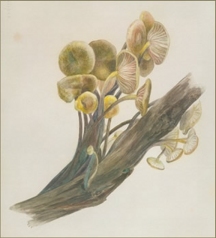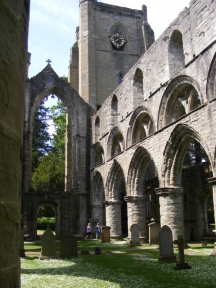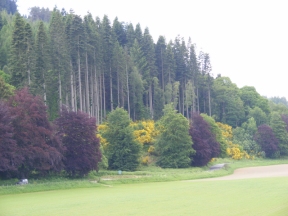Previous Chapter
Friday 6thJune 2008
Perth to Pitlochry
Another fine day – since that first wet afternoon we had been very lucky with the weather. It was slightly cloudy and not too hot – just the right weather for riding. We headed north west towards Pitcairngreen getting slightly confused as we approached the village of Almondbank – I think that Sustrans must have changed route 77 here as we lost the signs for a while.  We then headed north crossing several valleys and streams en route ending up at Bankfoot. No sign of a café here, so as it was still early we headed on to the village of Birnam on the outskirts of Dunkeld. The landlady in Perth had told us that it was worth calling in to the arts centre here, which houses an exhibition celebrating the life of Beatrix Potter. So after tea in the café, we spent almost an hour looking at the exhibits and learning about her life as an artist and writer. She was especially interested in Fungi and her family came to Dunkeld to spend summer holidays over several years. It was here that she met Charles McIntosh, the village postman and naturalist who was greatly impressed by the accuracy of her work. She devoted many hours to this even writing a paper on the germination of spores which was rejected at the time but is now thought to be correct. It was a privilege to see some of Beatrix Potter’s original paintings and drawings here – mostly of fungi.
We then headed north crossing several valleys and streams en route ending up at Bankfoot. No sign of a café here, so as it was still early we headed on to the village of Birnam on the outskirts of Dunkeld. The landlady in Perth had told us that it was worth calling in to the arts centre here, which houses an exhibition celebrating the life of Beatrix Potter. So after tea in the café, we spent almost an hour looking at the exhibits and learning about her life as an artist and writer. She was especially interested in Fungi and her family came to Dunkeld to spend summer holidays over several years. It was here that she met Charles McIntosh, the village postman and naturalist who was greatly impressed by the accuracy of her work. She devoted many hours to this even writing a paper on the germination of spores which was rejected at the time but is now thought to be correct. It was a privilege to see some of Beatrix Potter’s original paintings and drawings here – mostly of fungi.
 Our next stop was the cathedral at Dunkeld about 1 mile away, but first we popped into the local bread shop to buy lunch. Dunkeld cathedral is situated right on the banks of the River Tay and it was under the trees that we sat eating our lunch watching the black headed gulls squabbling over the morsels being thrown by other visitors. The cathedral used to be the most important in Scotland as it housed the relic of St Columba. When the relic was moved to St Andrews in the 10th century it ceased to be as important. Dunkeld is another cathedral that suffered great changes at the time of the reformation – unlike Dunblane it was not rebuilt and the nave and the tower at the west end remain in ruins. It was decided in the mid 1500’s that the choir alone should be used as a church and this structure dates from about 1300. The nave and tower were built in the 1400’s but about 150 years later the roof of the nave was removed by the laird of Cardeny
Our next stop was the cathedral at Dunkeld about 1 mile away, but first we popped into the local bread shop to buy lunch. Dunkeld cathedral is situated right on the banks of the River Tay and it was under the trees that we sat eating our lunch watching the black headed gulls squabbling over the morsels being thrown by other visitors. The cathedral used to be the most important in Scotland as it housed the relic of St Columba. When the relic was moved to St Andrews in the 10th century it ceased to be as important. Dunkeld is another cathedral that suffered great changes at the time of the reformation – unlike Dunblane it was not rebuilt and the nave and the tower at the west end remain in ruins. It was decided in the mid 1500’s that the choir alone should be used as a church and this structure dates from about 1300. The nave and tower were built in the 1400’s but about 150 years later the roof of the nave was removed by the laird of Cardeny
 We then followed the cycle trail through a parkland at the rear of the Cathedral and along the banks of the Tay until we reached the A9 which we used to cross over to the west bank of the river and join the minor road leading north to Pitlochry. Craigvinean Forest stretched away to our left and there were magnificent Copper beech trees lining the road. Just outside the village of Balmacneil there was an old iron railway bridge (now disused) which took us across the Tay and from here on we followed the river Tummel into Pitlochry. Time for tea again and also time to enquire about a cycle shop. At sometime in the last couple of days we had picked up a nasty gash in the front tyre – and although this hadn’t resulted in a puncture the idea of riding through the wilds of Scotland without a backup was perhaps silly. The cycle shop had a suitable spare which we fitted that evening at the B&B closely supervised by the pet rabbit. The B&B was next to the station and we had a good view of the trains passing the bedroom window with station announcements to let us know when they were coming.
We then followed the cycle trail through a parkland at the rear of the Cathedral and along the banks of the Tay until we reached the A9 which we used to cross over to the west bank of the river and join the minor road leading north to Pitlochry. Craigvinean Forest stretched away to our left and there were magnificent Copper beech trees lining the road. Just outside the village of Balmacneil there was an old iron railway bridge (now disused) which took us across the Tay and from here on we followed the river Tummel into Pitlochry. Time for tea again and also time to enquire about a cycle shop. At sometime in the last couple of days we had picked up a nasty gash in the front tyre – and although this hadn’t resulted in a puncture the idea of riding through the wilds of Scotland without a backup was perhaps silly. The cycle shop had a suitable spare which we fitted that evening at the B&B closely supervised by the pet rabbit. The B&B was next to the station and we had a good view of the trains passing the bedroom window with station announcements to let us know when they were coming.
Mileage 32.3 miles Total 189.3 miles